QUESTIONS FOR CRAFTERS: takashi iwasaki
Interview by Amy Borkwood
Takashi Iwasaki is a multi-disciplinary artist from Japan, who studied in Winnipeg, and whose work is currently showing at LE Gallery in Toronto. He works in varying forms, from illustration to wood-working (as I learned in this interview), and his embroideries are stunning. Over the last week we discussed the practice and process of his art, and the nature of his craft.
Find his work online at takashiiwasaki.info, or in person at LE Gallery until Oct 19th.
Can you tell me a bit about your background: how and when did you find yourself interested in making? You went to school for art, and now show in solo and group exhibitions across the country - can you tell me a bit about those experiences?
I've loved making art since I was very little. I was drawing cartoon characters from Dragon Ball Z, my favourite cartoon back then, when I was in an elementary school - yeah, I know it's very typical of a little kid thing to do, being influenced by a cartoon, but you know, I grew up in Japan. It was a part of everyday life to be exposed to such things and to be influenced by those.
I always wanted to do something art-related in my life for living. Then I had an opportunity to study fine arts in Canada. I always wanted to study fine arts and English at the same time, but Japan is such a mono-cultural country where everyone speaks in Japanese. In that environment if I studied English, I wouldn't have had time to study fine arts, and vise versa. But in Canada where English is one of the official languages, I had to speak in English everyday, and was able to take fine arts as my subject of education. So studying in North America worked very well for me. I've met great teachers and artists while I was at the University of Manitoba. Coming to Winnipeg was certainly one of the best things I had done in my life.
Winnipeg isn't necessarily the hottest spot for visual arts because of its relatively small population and its art market, but it's a decent size city - not too small, not too big, just the right size for what I want - and the cost of living is very reasonable. Winnipeg, located in the center of North America, the shipping cost of my work to galleries is the same to East to West to South, which is a great advantage to me. As a visual artist, I don't always have to live in a big city, as long as I have galleries to show my work in larger cities and am able to deliver my work to them.
Showing my work in solo and group shows has been a very exciting thing for me, as all the artists love to do. I love getting feedbacks from the audience, which has always been an encouraging and motivating factor for me to keep making art. Having exhibitions helps me show my work to people, helps me make living from the sales, and is a good excuse for me to travel to those cities where I have shows. It's definitely an essential part of my career.
In your work you utilize many different mediums - from painting to collage to print-making, and, of course, your embroidery work. What draws you to all these very different mediums? Do specific ideas influence the medium?
I love having lot of materials to work with and projects on my plate. Why would I limit myself when the sky is the limit, right? Having different options and working with them keep my mentality flexible, sharp and active. I get bored of doing only one thing everyday. You know, you don't want your life to be a mundane - it's basically the same thing for my art making process. Painting, embroidering, collage making, and so on and on - those methods of art making feed off each other and give me more ideas and food for thoughts. I also make wooden sculptures in the similar designs you see in my embroidery and painting works, which I haven't shown to many people yet. I have other long-term projects and goals such as designing my own house and having it built, and designing my own coffee shop and managing it. I've been enjoying designing my house with this program called SketchUp, offered for free from Google. Try it out if you're interested.
You create both abstract and "realistic" art - what informs each style? Do you have a preference of one style over another?
I started with more representational and traditional way of making art. I always think it's good to be able to draw or paint "realistically." It's a fundamental skill and an indication of how well you can observe things. It seems like many schools, teachers and students nowadays don't take the fundamental skills in drawing very seriously, but rather to push the conceptual aspect of art making instead. I guess that tendency is alright, but to me it seems like constructing a building without having a solid foundation underneath. Those buildings tend to collapse and won't be able to build up that much more on top. The capability in the visually accurate drawing isn't a must-have, but is definitely a good-to-have in my opinion. I use both abstract and "realistic" ways of expression as necessary. One fits better than the other depending on what I want to express in what manner. However, I've been employing abstraction more lately because of its seemingly wider and less limited range of interpretation it has.
Your work shows an appreciation for colour, shape, pattern. What inspires your use of these elements in each piece?
As most of my abstract works nowadays are my diary entries - instead of writing down what I did on one day or in a period of time, I make visual artworks to record those events - things which appear in my works are often inspired by the colors, shapes, patterns which I encounter with in a period of time, and are also influenced by my emotional reactions to those events which are transformed into certain forms. I often capture positive elements in those events, so the color combinations also tend to look positive and happy. I'm a big sucker for architectural elements and patterns, so those subject matters tend to appear often in my recent works.
Can you tell me about the process of your embroidered work? Do you have a plan for each piece, how much time goes into each embroidery?
I usually sketch out the outlines on paper, then transfer that sketch to fabric. At that point most of the colors aren't determined yet. The choice of colors is sort of kept undetermined for my joy of selecting colors as I embroider. If everything was determined in the beginning, art making would be rather a mission to complete than an enjoyable activity. I always want to feel joy for what I do. That attitude is carried through any of the mediums I choose to make art with as well as my lifestyle. That's one of the reasons why I call myself an "Art Enjoyer," which is also written as my title on my business card. A typical embroidery piece is completed in between 5 hours to 20 hours depending on the size I'm working with.
I'm really interested in what you said about designing your own house and coffee shop: I love that your work takes form not only in specific artworks but in your everyday life, in creating the space where you live and work. Are there other items in your everyday life that you design or create?
I don't see creating my artwork as something overly more special than anything else I do in my life. I love cooking, inviting people for meals, hanging out with my friends, meeting new people, and so on and on. I need all of them and beyond to enjoy my life. I decided to choose art making as a more prominent part of my career at this stage of my life because it seems like the most fitting thing for my ideal lifestyle to me right now.
Who is inspiring you right now? Are there any artists, etc, who have been long-term influences to your work?
As most of my artworks I make nowadays are my personal visual diary entries, everything which captures my attention in everyday life could be a source of my inspiration. To name visual artists whose work I love, Paul Klee and Rex Ray always come to the top of my list.
:::::::::::
Amy Borkwood is a bookbinder and freelance arts-writer living in Toronto. Her bookworks can be found at her online shop, Nightjar Books.
Takashi Iwasaki is a multi-disciplinary artist from Japan, who studied in Winnipeg, and whose work is currently showing at LE Gallery in Toronto. He works in varying forms, from illustration to wood-working (as I learned in this interview), and his embroideries are stunning. Over the last week we discussed the practice and process of his art, and the nature of his craft.
Find his work online at takashiiwasaki.info, or in person at LE Gallery until Oct 19th.
Can you tell me a bit about your background: how and when did you find yourself interested in making? You went to school for art, and now show in solo and group exhibitions across the country - can you tell me a bit about those experiences?
I've loved making art since I was very little. I was drawing cartoon characters from Dragon Ball Z, my favourite cartoon back then, when I was in an elementary school - yeah, I know it's very typical of a little kid thing to do, being influenced by a cartoon, but you know, I grew up in Japan. It was a part of everyday life to be exposed to such things and to be influenced by those.
I always wanted to do something art-related in my life for living. Then I had an opportunity to study fine arts in Canada. I always wanted to study fine arts and English at the same time, but Japan is such a mono-cultural country where everyone speaks in Japanese. In that environment if I studied English, I wouldn't have had time to study fine arts, and vise versa. But in Canada where English is one of the official languages, I had to speak in English everyday, and was able to take fine arts as my subject of education. So studying in North America worked very well for me. I've met great teachers and artists while I was at the University of Manitoba. Coming to Winnipeg was certainly one of the best things I had done in my life.
Winnipeg isn't necessarily the hottest spot for visual arts because of its relatively small population and its art market, but it's a decent size city - not too small, not too big, just the right size for what I want - and the cost of living is very reasonable. Winnipeg, located in the center of North America, the shipping cost of my work to galleries is the same to East to West to South, which is a great advantage to me. As a visual artist, I don't always have to live in a big city, as long as I have galleries to show my work in larger cities and am able to deliver my work to them.
Showing my work in solo and group shows has been a very exciting thing for me, as all the artists love to do. I love getting feedbacks from the audience, which has always been an encouraging and motivating factor for me to keep making art. Having exhibitions helps me show my work to people, helps me make living from the sales, and is a good excuse for me to travel to those cities where I have shows. It's definitely an essential part of my career.
In your work you utilize many different mediums - from painting to collage to print-making, and, of course, your embroidery work. What draws you to all these very different mediums? Do specific ideas influence the medium?
I love having lot of materials to work with and projects on my plate. Why would I limit myself when the sky is the limit, right? Having different options and working with them keep my mentality flexible, sharp and active. I get bored of doing only one thing everyday. You know, you don't want your life to be a mundane - it's basically the same thing for my art making process. Painting, embroidering, collage making, and so on and on - those methods of art making feed off each other and give me more ideas and food for thoughts. I also make wooden sculptures in the similar designs you see in my embroidery and painting works, which I haven't shown to many people yet. I have other long-term projects and goals such as designing my own house and having it built, and designing my own coffee shop and managing it. I've been enjoying designing my house with this program called SketchUp, offered for free from Google. Try it out if you're interested.
You create both abstract and "realistic" art - what informs each style? Do you have a preference of one style over another?
I started with more representational and traditional way of making art. I always think it's good to be able to draw or paint "realistically." It's a fundamental skill and an indication of how well you can observe things. It seems like many schools, teachers and students nowadays don't take the fundamental skills in drawing very seriously, but rather to push the conceptual aspect of art making instead. I guess that tendency is alright, but to me it seems like constructing a building without having a solid foundation underneath. Those buildings tend to collapse and won't be able to build up that much more on top. The capability in the visually accurate drawing isn't a must-have, but is definitely a good-to-have in my opinion. I use both abstract and "realistic" ways of expression as necessary. One fits better than the other depending on what I want to express in what manner. However, I've been employing abstraction more lately because of its seemingly wider and less limited range of interpretation it has.
Your work shows an appreciation for colour, shape, pattern. What inspires your use of these elements in each piece?
As most of my abstract works nowadays are my diary entries - instead of writing down what I did on one day or in a period of time, I make visual artworks to record those events - things which appear in my works are often inspired by the colors, shapes, patterns which I encounter with in a period of time, and are also influenced by my emotional reactions to those events which are transformed into certain forms. I often capture positive elements in those events, so the color combinations also tend to look positive and happy. I'm a big sucker for architectural elements and patterns, so those subject matters tend to appear often in my recent works.
Can you tell me about the process of your embroidered work? Do you have a plan for each piece, how much time goes into each embroidery?
I usually sketch out the outlines on paper, then transfer that sketch to fabric. At that point most of the colors aren't determined yet. The choice of colors is sort of kept undetermined for my joy of selecting colors as I embroider. If everything was determined in the beginning, art making would be rather a mission to complete than an enjoyable activity. I always want to feel joy for what I do. That attitude is carried through any of the mediums I choose to make art with as well as my lifestyle. That's one of the reasons why I call myself an "Art Enjoyer," which is also written as my title on my business card. A typical embroidery piece is completed in between 5 hours to 20 hours depending on the size I'm working with.
I'm really interested in what you said about designing your own house and coffee shop: I love that your work takes form not only in specific artworks but in your everyday life, in creating the space where you live and work. Are there other items in your everyday life that you design or create?
I don't see creating my artwork as something overly more special than anything else I do in my life. I love cooking, inviting people for meals, hanging out with my friends, meeting new people, and so on and on. I need all of them and beyond to enjoy my life. I decided to choose art making as a more prominent part of my career at this stage of my life because it seems like the most fitting thing for my ideal lifestyle to me right now.
Who is inspiring you right now? Are there any artists, etc, who have been long-term influences to your work?
As most of my artworks I make nowadays are my personal visual diary entries, everything which captures my attention in everyday life could be a source of my inspiration. To name visual artists whose work I love, Paul Klee and Rex Ray always come to the top of my list.
:::::::::::
Amy Borkwood is a bookbinder and freelance arts-writer living in Toronto. Her bookworks can be found at her online shop, Nightjar Books.
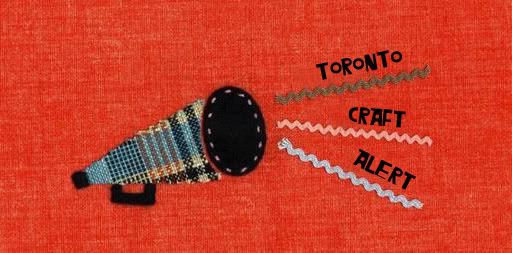

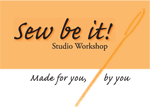




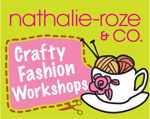


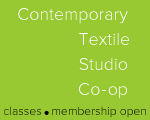

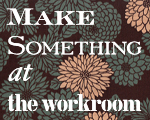

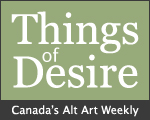

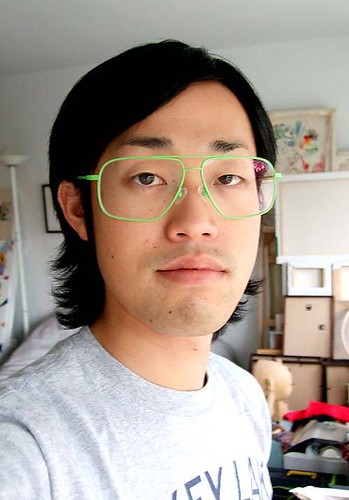

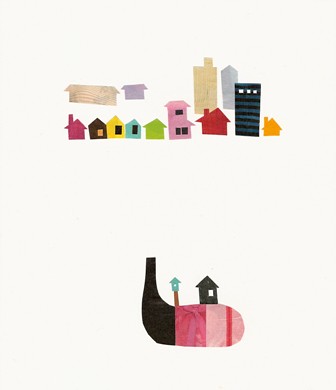
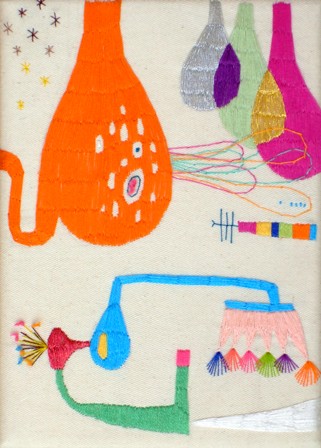

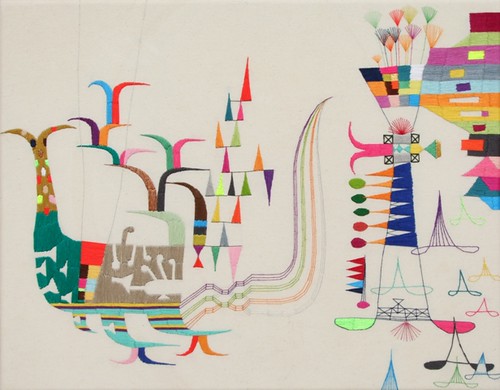
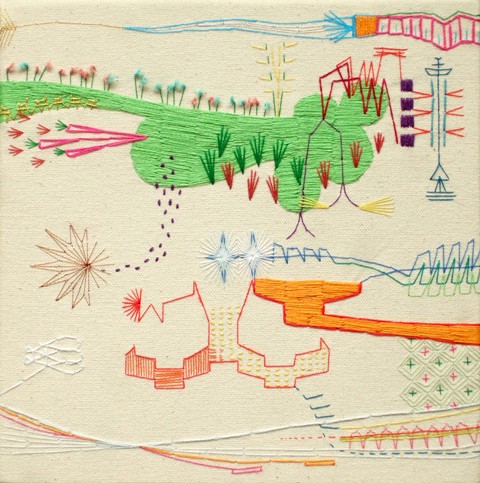







2 Comments:
It's great to see Takashi here! He was actually a classmate of ours and such a sweet person. His work is truly fantastic!
i love. great interview!
Post a Comment
<< Home